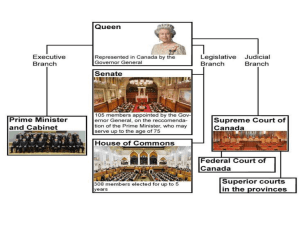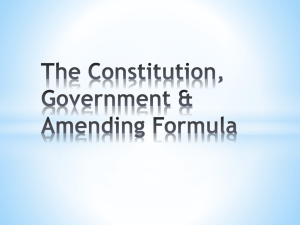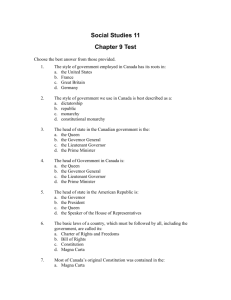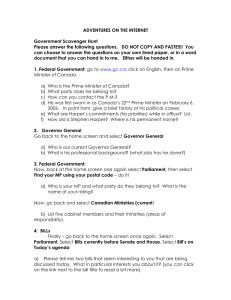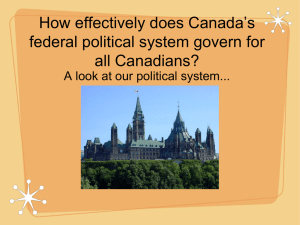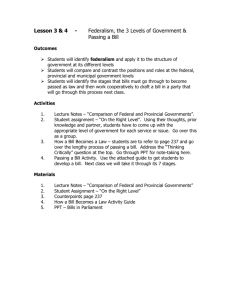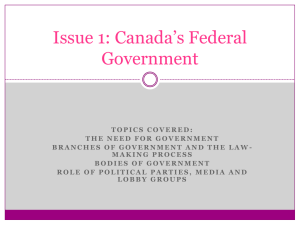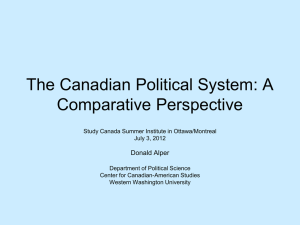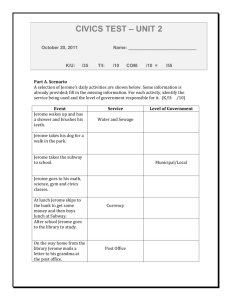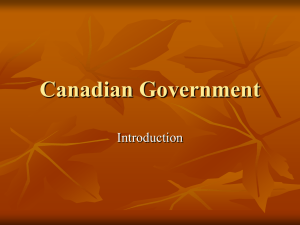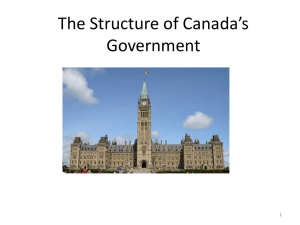Branches of Canadian Government
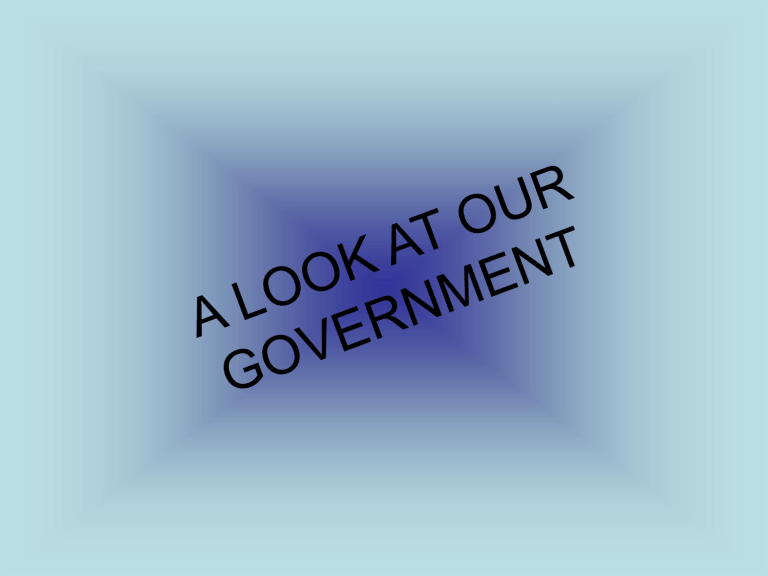
FEDERAL GOVERNMENT
Executive Branch
QUEEN
Formal Executive
Legislative Branch
SENATE
HOUSE OF
COMMONS
GOVERNOR
GENERAL
Judicial Branch
PRIME
MINISTER
Political Executive
SUPREME
COURT OF
CANADA
CABINET
FEDERAL
COURT
PROVINCIAL GOVERNMENT
Executive Branch
QUEEN
Formal Executive
Legislative Branch
LEGISLATURE
LIEUTENANT
GOVERNOR
PREMIER
Political Executive
Judicial Branch
SUPREME
COURT OF
PROVINCE
CABINET
PROVINCIAL
COURTS
EXECUTIVE BRANCH OF GOVERNMENT
The Executive Branch carries out the plans and policies of the government.
At the Federal Level of government, the Executive branch is made up of the Prime Minister, the Cabinet, and the public service.
At the Provincial Level it is made up of the Premier, the
Provincial cabinet and the provincial public service.
Canada’s constitution declares that all laws are made in the name of the Queen, represented by the Governor General at the Federal Level, and the Lieutenant Governor at the
Provincial Level.
The daily running of the government is done by the Prime
Minister and Cabinet at the Federal Level and the Premier and
Cabinet at the Provincial Level.
MEMBERS OF THE EXECUTIVE
GOVERNOR GENERAL: The Governor General is the representative of Queen Elizabeth in Canada and performs the duties that the Queen would do if she were here. The Governor General gives royal assent to
Laws, greets foreign dignitaries, appoints senators and Supreme Court
Judges, and begins sessions of Parliament. The Lieutenant Governor does the same duties in the Province.
PRIME MINISTER: Is the leader of the Canada and head of the Federal
Government. He speaks on behalf of all Canadians at national and international meetings. He addresses citizens on issues of the nation, and represents Canada on trips abroad. The Prime Minister also recommends new judges and senators for appointment. And, as head of his political party, he also acts as spokesperson for that party.
CABINET: Is the group of ministers that decides what the government policy should be. Cabinet Members are chosen by the Prime Minister and have responsibility for particular departments of government, such as Foreign Affairs, Defence, and Justice. Members of the Cabinet are called Ministers, and the Prime Minister leads the Cabinet.
LEGISLATIVE BRANCH OF GOVERNMENT
HOUSE OF COMMONS
The Legislative Branch of Government, also called Parliament, is the branch that has the power to make, change and cancel laws.
The most powerful part of the Legislative Branch at the federal level is the House of Commons in Ottawa. Elected representatives meet to discuss and vote on public issues in the House of
Commons. Representatives at the federal level are called
Members of Parliament or MPs.
MPs and regularly discuss and debate issues and government policies. These debates are controlled by the Speaker of the
House (also an MP).
The legislature in the Province models the House of Commons and the representatives at the provincial level are called Members of Provincial Parliament or MPPs.
SENATE
The Senate is referred to as the “upper house of Parliament.”
The Senate may propose bills, or ammend and repeal bills passed by the House of Commons.
The Senate was established to reflect the British Parliament.
The theory was that the Senate would serve as a reasonable check on the House of Commons.
Senators are not elected. They are appointed by the Governor
General on the recommendation of the Prime Minister. They may serve until they are 75 years of age.
In practice, the Senate acts as a “rubber stamp” for the House of
Commons.
The Provincial Government does not have a Senate.
JUDICIAL BRANCH OF GOVERNMENT
The Judicial Branch is the part of government that deals with the law.
In Canada, this branch is separate from the other two branches. This ensures that Parliament and its members are not above the law.
The Judicial Branch is made up of the courts and the judges.
They determine if people charged with crimes are guilty or innocent and decide on punishments for those found guilty.
They also interpret laws when disputes arise between individuals, groups, or even different levels of government.
